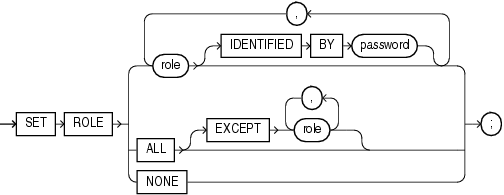| Oracle® Database SQL Language Reference 11g Release 2 (11.2) Part Number E26088-02 |
|
|
PDF · Mobi · ePub |
| Oracle® Database SQL Language Reference 11g Release 2 (11.2) Part Number E26088-02 |
|
|
PDF · Mobi · ePub |
When a user logs on to Oracle Database, the database enables all privileges granted explicitly to the user and all privileges in the user's default roles. During the session, the user or an application can use the SET ROLE statement any number of times to enable or disable the roles currently enabled for the session.
You cannot enable more than 148 user-defined roles at one time.
Notes:
For most roles, you cannot enable or disable a role unless it was granted to you either directly or through other roles. However, a secure application role can be granted and enabled by its associated PL/SQL package. See the CREATE ROLE semantics for USING package and Oracle Database Security Guide for information about secure application roles.
SET ROLE succeeds only if there are no definer's rights units on the call stack. If at least one DR unit is on the call stack, then issuing the SET ROLE command causes ORA-06565. See Oracle Database PL/SQL Language Reference for more information about definer's rights units.
To run the SET ROLE command from PL/SQL, you must use dynamic SQL, preferably the EXECUTE IMMEDIATE statement. See Oracle Database PL/SQL Language Reference for more information about this statement.
You can see which roles are currently enabled by examining the SESSION_ROLES data dictionary view.
See Also:
CREATE ROLE for information on creating roles
ALTER USER for information on changing a user's default roles
Oracle Database Reference for information on the SESSION_ROLES session parameter
You must already have been granted the roles that you name in the SET ROLE statement.

Specify one or more roles to be enabled for the current session. All roles not specified are disabled for the current session or until another SET ROLE statement is issued in the current session.
In the IDENTIFIED BY password clause, specify the password for a role. If the role has a password, then you must specify the password to enable the role.
Restriction on Setting Roles You cannot specify a role identified globally. Global roles are enabled by default at login, and cannot be reenabled later.
Specify ALL to enable all roles granted to you for the current session except those optionally listed in the EXCEPT clause.
Roles listed in the EXCEPT clause must be roles granted directly to you. They cannot be roles granted to you through other roles.
If you list a role in the EXCEPT clause that has been granted to you both directly and through another role, then the role remains enabled by virtue of the role to which it has been granted.
Restrictions on the ALL Clause The following restrictions apply to the ALL clause:
You cannot use this clause to enable roles with passwords that have been granted directly to you.
You cannot use this clause to enable a secure application role, which is a role that can be enabled only by applications using an authorized package. Refer to Oracle Database Security Guide for information on creating a secure application role and Oracle Database 2 Day + Security Guide for a tutorial.
This clause only enables roles that do not require any authentication.
Specify NONE to disable all roles for the current session, including the DEFAULT role.
Setting Roles: Examples To enable the role dw_manager identified by the password warehouse for your current session, issue the following statement:
SET ROLE dw_manager IDENTIFIED BY warehouse;
To enable all roles granted to you for the current session, issue the following statement:
SET ROLE ALL;
To enable all roles granted to you except dw_manager, issue the following statement:
SET ROLE ALL EXCEPT dw_manager;
To disable all roles granted to you for the current session, issue the following statement:
SET ROLE NONE;